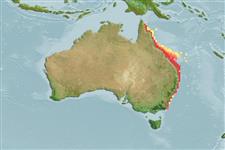Common names from other countries
Environment: milieu / climate zone / depth range / distribution range
Ecologia
marinhas; estuarina demersal; não migratória; intervalo de profundidade 0 - 50 m (Ref. 6205). Subtropical; 12°S - 39°S, 143°E - 157°E (Ref. 6205)
Western Pacific: endemic to Australia. Records of this species from western Australia or northern Australia refer to Sillago burrus. Also very similar to Sillago aeolus from southeast Asia (Sunda Shelf). Occurrence in Tanzania (Ref. 2871) is probably a misidentification.
Length at first maturity / Tamanho / Peso / Idade
Maturity: Lm 19.0 range ? - ? cm
Max length : 30.0 cm TL macho/indeterminado; (Ref. 6205); common length : 25.0 cm SL macho/indeterminado; (Ref. 9679)
Espinhos dorsais (total): 12 - 13; Raios dorsais moles (total): 19-21; Espinhos anais 2; Raios anais moles: 19 - 20; Vértebras: 34 - 36. Anterolateral extensions of swim bladder recurved posteriorly to reach level of vent. Base of pectoral fin with black spot, back and sides with dark blotches. The upper and lower blotches are frequently joined, at least posteriorly, the upper blotches are generally larger; the opercle is dull or with an inner dark blotch showing through. Coloration is similar to S. burrus and S. aeolus.
Occur on silty and muddy substrates in the deeper water of bays, but also frequenting the mouths of rivers, estuaries, and mangrove creeks. Juveniles abound in estuaries and shallow water during summer, moving deeper as they mature. Diet of juveniles consist largely of small crustaceans and that of the adult fish consist mainly of polychaete worms and bivalve mollusks. Oviparous (Ref. 205). Spawn throughout the year with peaks in Dec.-Feb. (Ref. 6390). Marketed fresh (Ref. 9987) and chilled (Ref. 6390).
They spawn several times each year (Ref. 26745).
McKay, R.J., 1992. FAO Species Catalogue. Vol. 14. Sillaginid fishes of the world (family Sillaginidae). An annotated and illustrated catalogue of the sillago, smelt or Indo-Pacific whiting species known to date. Rome: FAO. FAO Fish. Synop. 125(14):87p. (Ref. 6205)
Categoria na Lista Vermelha da IUCN (Ref. 130435)
CITES (Ref. 128078)
Not Evaluated
Ameaça para o homem
Harmless
Utilização humana
Pescarias: pouco comercial; Aquacultura: experimental; peixe desportivo: sim
Ferramentas
Relatórios especiais
Descarregue XML
Fontes da internet
Estimates based on models
Preferred temperature (Ref.
115969): 20.2 - 26.9, mean 25.1 (based on 98 cells).
Phylogenetic diversity index (Ref.
82804): PD
50 = 0.5000 [Uniqueness, from 0.5 = low to 2.0 = high].
Bayesian length-weight: a=0.00631 (0.00372 - 0.01070), b=3.10 (2.95 - 3.25), in cm Total Length, based on LWR estimates for this species & Genus-body shape (Ref.
93245).
Nível Trófico (Ref.
69278): 3.3 ±0.1 se; based on diet studies.
Resiliência (Ref.
120179): Elevada, tempo mínimo de duplicação da população menor que 15 meses (Preliminary K or Fecundity.).
Fishing Vulnerability (Ref.
59153): Low vulnerability (20 of 100).
